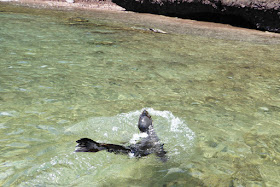This post covers only half of May 10. As with most days of this week-long Galapagos trip, it was almost non-stop.
We awoke at the Galapagos island of Floreana, having sailed west during the night.
Joan and I joined the pre-breakfast outing, which began with a wet landing at Punta Cormorant (named for a wrecked ship, not the bird). In Lindblad-speak, a "wet" landing means the zodiac will go as far up the beach as it can, and then you slide out into an inch to a foot of water and walk the rest of the way. This means wearing appropriate footwear, and perhaps changing it at the beach.
Punta Cormorant is known for its brackish-water lagoon that attracts flamingos, and for having two different kinds of sand: Green Beach, built from ground olivine crystals, and the Flour Beach, made from pulverized coral. Our wet landing was at Green Beach. We split into groups, and Joan and I joined the one led by the naturalist Jefferson "Jeffo" Marquez. A heavy fog hung over our heads as we made our way to the observation point for the flamingo lagoon, where it was difficult to see much.
The trail led up over a low ridge and back down, to the Flour Beach. Green sea turtles nest at this beach.
A frigate bird, hoping to spot an egg or baby turtle, patrolled up and down the beach.
Various other birds were using the beach, including yellow warbler, plover (probably semipalpated, but there are 5 species in the Galapagos), and sandpiper (25 species!) The lighting wasn't good for photographing active little birds ...
Sally Lightfoot crabs abounded.
What are these pits in the sand? (Click on the image to enlarge.)
Jeffo explained that they weren't green turtle nests, but were borrow pits from which the turtles scooped dirt to refill a nest and cover up the eggs. A true nest might be harbored somewhere around the rim.
We returned the way we had come,
to discover that visibility at the flamingo lagoon had improved.
Most of the flamingos were on the far side, sharing the waters with a heron ...
but two came in closer. Our binoculars proved worth carrying into a wet landing.
A striated heron snatched a meal.
Then it was time to return to Green Beach and the waiting zodiacs.
An alert went up! Just down the beach a pair of blue-footed boobies were going through courtship/bonding rituals. Here is a collage (click on the image to enlarge).
Returning to the ship, we launched into breakfast. Afterwards our expedition leader, Lynn Fowler, announced zodiac tours to the islet of Champion, barely off the coast of Floreana, to view wildlife and scout snorkeling locations. Of course Joan and I went. In this photo we're leaving the Islander behind.
There was more than one zodiac ... note the sea lion peeking up at left.
Vanessa Gallo was the naturalist on our craft.
She pointed out these prickly pear cacti, a variety elevated on trunks instead of growing closely to the ground. This occurs on islands where the plants would otherwise be consumed by herbivores including the land iguana, 80% of whose diet is the pads, fruits, flowers, and even spines of the prickly pear.
Also visible on Champion were candelabra cacti.
On our tour we saw sea lions on land, usually snoozing,
and curious pups in the waters around us,
sometimes several at once.
Resting birds included the brown noddy,
and the swallow-tailed gull.
As we turned around a frisky sea lion youngster saw us off.
Snorkeling time was imminent -- in the next post.


























No comments:
Post a Comment
Comments may not appear immediately as they are moderated by the author to eliminate spam. Please, no commercial links!